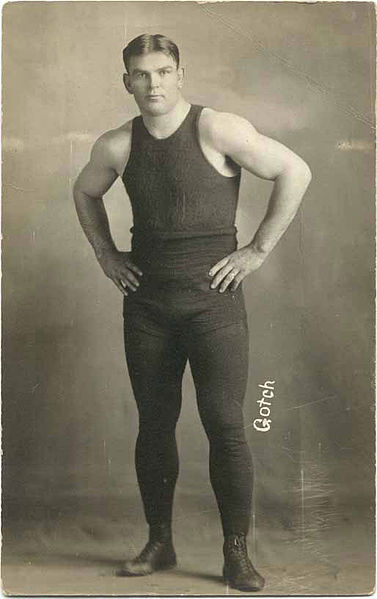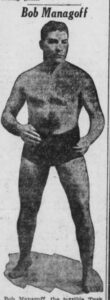Gotch Lov ceg
Tom qab marrying nws tus poj niam Gladys thiab beating Georg Hackenschmidt ib ob zaug, ob leeg nyob rau hauv ob leeg 1911, Ntiaj teb Heavyweight Wrestling Tau zus ib Frank Gotch pib wrestle ib lub sij hawm txwv ntau txwv. Nws tus poj niam Gladys twb tsis muaj kiv cua loj wrestling thiab xav nws tus txiv tshiab los siv sij hawm ntau nyob rau hauv Tsev nyob rau hauv Humboldt, Iowa.
Nyob hauv lub ntiaj teb wrestling thaum lub sij hawm, only Stanislaus Zbyszko was considered a serious challenger but Gotch had shown no interest in wrestling him again after beating Zbyszko in a controversial bout in 1910. With few serious challenges, Gotch defeated Georg Lurich in April 1913 and retired from the ring.

Frank Gotch los ntawm cov pej xeem sau ntawv
While Gotch was done with wrestling, it wasn’t done with him. Almost from the time he retired, other wrestlers and their promoters began issuing Gotch challenges for large sums of money. Like a retired gunfighter, every young wrestler of promise wanted to build his reputation on the aging former champion.
Gotch tried his best to ignore the taunts and challenges but after two years, he had enough of the many would-be champions’ posturing. It was at this time his former trainer, Martin “Ua teb” Zaus, stepped in with a plan.
Burns had been training an exceptional wrestler by the name of Joe Stecher. The 22-year-old Stecher almost defeated Dr. Ben Roller as a high school wrestler. Based on his reputation, he was matched with Charles Cutler for the American Heavyweight Championship in 1915.
Burns and Gotch planned for Stecher to beat Cutler for the American Heavyweight Championship, which he did in a worked or prearranged match. Txawm li cas los, no one doubted that Stecher would have won the contest as well.
Burns and Gotch would then build anticipation for a match between Stecher and Gotch. Gotch would lose to Stecher in a worked match to anoint Stecher as his successor, and more importantly, end the steady stream of challenges.
After nearly a year, the match was scheduled for the summer of 1916. To prepare for the match, the 39-year-old Gotch scheduled an exhibition or training match with Bob Managoff, Sr. in Kenosha, Wisconsin on July 18, 1916. Managoff was a solid professional, who would help Gotch get into shape for a credible match with Stecher.

Bob Managoff, Sr. los ntawm cov pej xeem sau ntawv
To the horror of everyone, disaster struck less than 2 minutes into the training match. Managoff and Gotch were in a traditional collar and elbow tie-up, when Gotch dropped to a knee to apply a hip hold takedown. Gotch’s left foot got stuck in the folds of the mat. An audible snap was heard. Gotch collapsed.
The freak accident fractured his calf bone and ended any chance for a Stecher-Gotch match that summer. Little did anyone know at the time that only 18 lub hlis tom ntej, Frank Gotch would die from the effects of uremic poisoning. The former champion was only 40-years-old.
Lots of rumors have swirled arounds Gotch’s death. People often look for what they see as a more plausible explanation, when a strong athlete like Gotch dies young. It is hard for people to accept that a world champion could suffer kidney failure at such a young age.
Koj yuav tawm ib saib los nug cov lus nug txog qhov no los yog tej tsev xa rau kuv Facebook phab.
Qhov chaw: The San Francisco Examiner, Lub Xya hli ntuj 19, 1916 ib tsab, p. 12 thiab The Oregon Daily Journal, Lub Xya hli ntuj 19, 1916 ib tsab, p. 11

